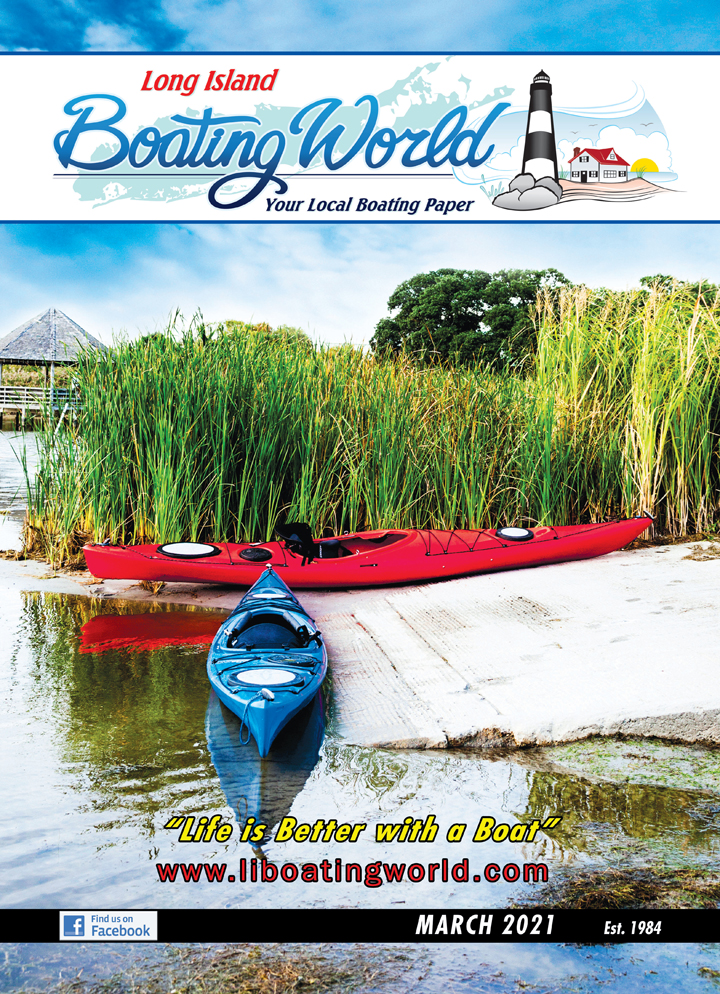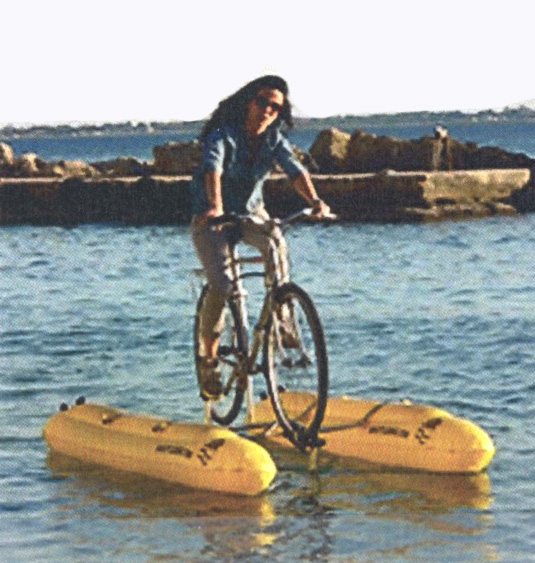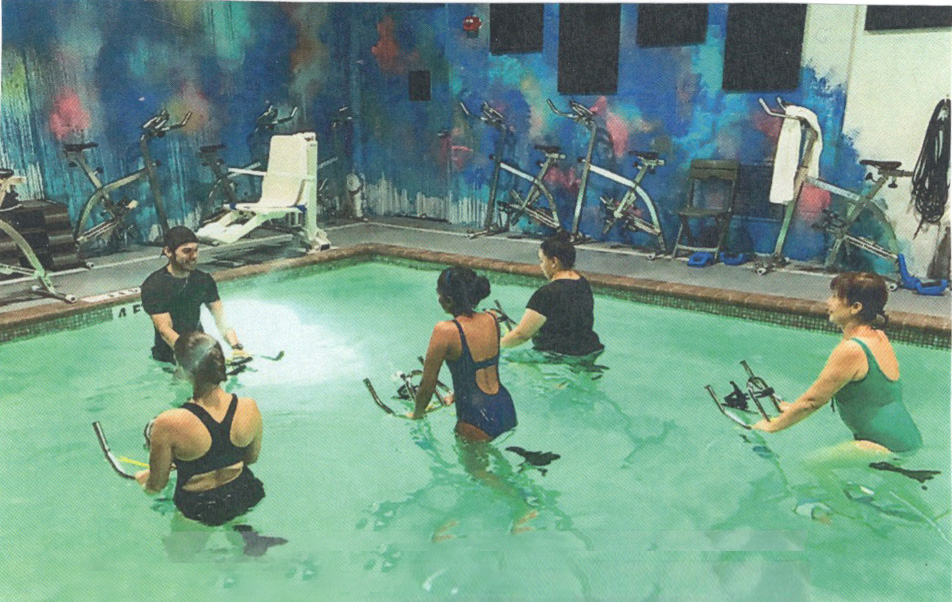
If you ask three people what water biking is, you could expect three different answers, including, “What’s that?” Water bikes have been around since the 1800s when they were called water velocipedes. More recently called amphibious cycles or hydrocycles, water bikes are propelled on land or through the water by human effort except for newer e bikes. Stationary bikes used in pools for physical therapy and fitness classes are also human driven. That’s the interesting part of water bikes – there are so many different versions and almost as many people claiming to have invented them. All are unique and fill a variety of needs.

As the aquaplanes of the 1920s and 1930s that required a towboat morphed into the independently propelled power ski, so the newer more recent models of the water bike have called on newer technology to create e bikes. The Manta5 e bike made in New Zealand is a design created by two bikers. One of the bikers is also a bike designer. They wanted to be able to ride a bike on the water. The Manta’s frame is aircraft grade aluminum and its hydrofoils and propeller are carbon fiber. It weighs 48 pounds and at its widest is 6’ 7”. It comes apart to fit into your car. Designed to be transportable, lightweight and quick to assemble, the bike will get up to 6.8 to 8.7 miles per hour. The bike uses a fully charged lithium battery and pedal power for an hour’s ride and to launch you upward from your submerged start.
Depending on where you look, the price for a Manta5 e bike varies from about $7,500 to $8,900 plus tax, plus shipping which they say varies from $300 to $1,000. If price is no problem, the Manta5 e bike has been described as an effortless ride on a sleek looking hydrofoil. The submerged start would mean a winter ride dressed in a drysuit or a combination of wetsuit parts to keep you warm and dry head to toe.
The Hydrobike was invented by Ray Buresch in 1989. Buresch and the Aeronautical Engineering professor at the University of Minnesota worked on developing the human propulsion system the professor was working on. They commissioned a canoe designer to design the hulls their bike would ride on as a twin-hull craft. Although there was no Internet then the way we know it now, through word of mouth, trade shows, print media and later their website, thousands of their bikes have been sold.
Hydrobike now makes three models – the Explorer, pedal powered by one person, the Cruiser, an e powered model and the Explorer II, a double pedal powered bike. The Explorer sells for about $2,000 and the Explorer II runs over $4,000.

In 2014 Judah Schiller invented his water bike that costs about $4,500 and there is a more advanced model that costs about $6,000. Schiller has been selling his bikes to resort owners and the bikes are becoming one of the amenities vacationers look for when making reservations at Caribbean resort hotels on the water. Schiller expects that in five years there will be Schiller bikes on every hotel beach around the world. Looking ahead, he sees racing as potential for the bikes and is organizing a water bike race in the south of France.
For the do-it-yourselfers there’s the Shuttle Bike Kit. Starting with a Flatbike (a bike that folds in half for easy transport), you add the two inflatable pontoons, a combination fin-propeller, modular tube framing and a pump for the pontoons (done by pedaling your bike), put it all together and if you did everything right, you’re ready to go. The Kit costs $1,500 and the bike is separate.
The Aquatic Bike, the in-water version of the water bike, has been made in the US since 1987 and is used in hospital programs with the reputation of being user friendly. The thermoplastic bikes have no rough edges and require no maintenance.
If your vacation plans do not include hotels with extensive beach areas such as the Caribbean or other exotic locations likely to have water bikes, where do you find them? If your travels take you to northern New York State, Water Bikes of Buffalo not only have water bikes to rent from Memorial Day to Labor Day, in the colder months on weekends from Thanksgiving to March, they have 18 ice bikes they rent. Being on the edge of the Buffalo River they offer the scenic neighborhoods and safety and security of the restored shallow canals. In Florida the Tampa Bay Water Bike Company has a fleet of water bikes that look from the pictures like Hydrobike Explorers behind the Tampa Convention Center.
To use an in-water water bike you’ll want to go to a pool that offers classes. Doing a spin class on a water bike is a lower impact experience that will give you whole body toning. In-water biking originated in Italy as a therapeutic way to rehabilitate patients who had long hospital stays. There are also circuit classes that will use aqua steppers and aqua treadmills. Pedaling the bike against the water in a heated pool tends to leave the biker relaxed and sleepy. Evening classes are very popular – it’s not only fun, it helps you sleep. In New York City Aqua Studio on Franklin Street has the pool, the bikes and the classes (212-966-6784 or aquastudiony.com).
There are benefits that in-water biking offers, especially in cold winter months – the warmth and comfort of the heated water in the pool when outside, the ice and snow make biking more of a hazard than fun. Making immune cells more active and increasing brainpower 15% are also attributable to biking.
For those of you who have seen the bikes, perhaps have tried them on vacation, before you call Amazon and order one, there are things to consider. If you plan to use a water bike a distance from home, you need a place to store it. Is there room in the garage? Do you have an RV parked out back and would it fit in there just to store it? If you are waterfront and plan to just use the water bike as a now and then thing from your dock, you still need a place to keep it out of the weather.
If you have not tried out the water bike you plan to buy, what if you get caught in a fast-moving storm – would it be “drive you crazy slow” trying to outrun the storm and get home? If it needs to be taken apart to travel, notice how much time it takes. Would that be a deal breaker?
Notice the brands of water bikes rental places use. Their goal is to have all the water bikes working when their season opens and it’s likely that a brand most rental places like has a few good points like price and reliability and low maintenance. Most of the brands have videos that you can watch and here is where you notice how stable the water bikes are. There is a noticeable difference you should experience before you buy.
The water bikes are probably considered personal watercraft but I haven’t seen anything about their classification. If you notice in the pictures, what’s missing – life jackets. As the number of water bike accidents increase the need becomes apparent that the people who use them need to wear life jackets if they’re going for a ride and don’t know how to swim and they’ll need to learn the rules of the road so they don’t get in the way of fast moving boat traffic.
